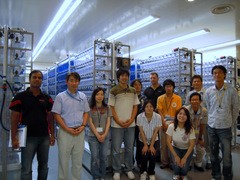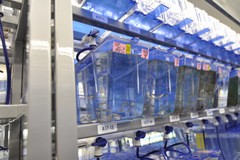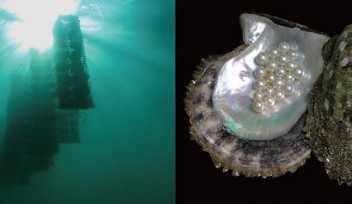The world’s most complicated fish tank

|
Anyone who has raised pet fish knows the delicate and painstaking work required to make them thrive. Water quality and room temperature must be maintained at a stable level, and regular and appropriate quantities of food must be supplied.
OIST has an advanced high capacity aquarium system developed for the maintenance of mutant and transgenic lines of zebrafish. The state-of-the-art zebrafish facility houses 4,600 fish tanks, with approximately 400,000 fish swimming around at any given time. The Developmental Neurobiology Unit, led by Dr. Ichiro Masai, uses the zebrafish as a model system to study the mechanisms that control cell development in fish retinas.
|
The members of the Developmental Neurobiology Unit with vendor staff on the day zebrafish were first placed in water tanks |
Maintaining a zebrafish facility is somewhat like keeping a huge tropical fish water tank. The facility is divided into two areas: one for breeding and raising the fish in tanks, and the other, a pump room for preparation and recirculation of water. Instead of laying gravel at the bottom of a fish tank as in the case in normal aquariums, the OIST zebrafish facility is equipped with multiple water filters to remove debris and toxic chemicals such as ammonia and nitrite contained in fish waste. Multiple water filters are classified into two groups: mechanical filters and biological filters. Mechanical filters remove debris to purify water. On the other hand, biological filters are made of porcelain or plastic particle, and provide scaffold for bacteria that inactivate ammonia and nitrite by oxidizing them into harmless chemical, nitrate. The water is circulated and purified through porcelain filters until ammonia and nitrite are entirely eliminated.
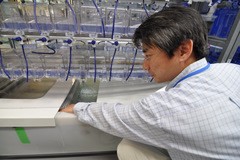
|
| Dr. Masai shows a porcelain biological filter in the sump. |
The filtered water is then transported to the adjacent pump room, where it again goes through more fine mechanical filters and the second biological filters made of plastic particles. Equipped with an automatic touch-panel controller on the wall, this room is used for sterilizing and generating aquarium water. In the process of sterilization, water goes through pipes installed with ultraviolet (UV) lamps. Aside from the level of UV emission, the system controller also keeps potential Hydrogen (pH) levels, electrical conductivity levels, and water output levels at optimum rates. In addition to these water purification equipments, 10 percent of the total water is exchanged daily with new water prepared by adding deionized water with alkali and salt solution. This daily 10% exchange is important for preventing the increase of a nitrate level.
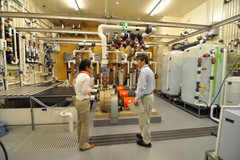
|
| The pump room |
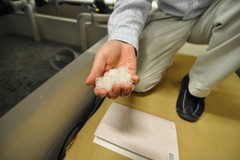
|

|
| Particle biological filters | The touch-panel system controller |
Feeding the fish is another vital element for the success of this intricate system. Since overfeeding means more ammonia in the water tanks, the members of the Developmental Neurobiology Unit need to carefully measure the amount, timing, and freshness of the food. The zebrafish are given live brine shrimp, which are imported as dry eggs from Salt Lake City in U.S.A. The staff feed the fish twice a day, each and every day of the year.
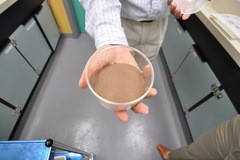
|
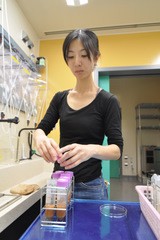
|
| Brine shrimp eggs | Brine shrimp eggs hatch when mixed with salt water |
Keeping detailed logs of the information about individual fish strains, from the date of birth, to its genetic information, and current and past health conditions is another important task in maintaining the zebrafish facility. The OIST zebrafish facility possesses around 100 wildtype, mutant and transgenic strains. This facility contributes to a bio-resource project by supplying valuable zebrafish strains to international and domestic research communities.

|
| Log book |
The zebrafish at OIST must be some of the most carefully nurtured fish in the world. The final result of this rigorous attention is a more profound scientific understanding on developmental processes of the zebrafish retina.






